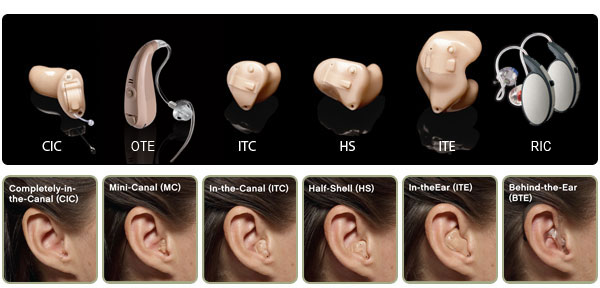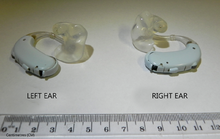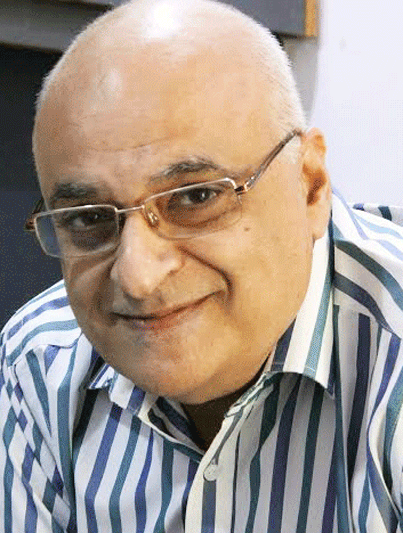
HEARING AIDS
A hearing aid is an electroacoustic device which is designed to amplify sound for the wearer, usually with the aim of making speech more intelligible, and to correct impaired hearing as measured by audiometry. In the United States, Hearing aids are considered medical devices and are regulated by the Food and Drug Administration (FDA). Ordinary small audio amplifiers or other plain sound reinforcing systems cannot be sold as "hearing aids".
Earlier devices, known as ear trumpets or ear horns, were passive funnel-like amplification cones designed to gather sound energy and direct it into the ear canal. Similar devices include the bone anchored hearing aid, and cochlear implant.
Body worn aids
This was the first type of hearing aid invented by Harvey Fletcher while working at Bell Laboratories. Body aids consist of a case and an earmold, attached by a wire. The case contains the electronic amplifier components, controls and battery while the earmold typically contains a miniature loudspeaker. The case is typically about the size of a pack of playing cards and is carried in a pocket or on a belt. Without the size constraints of smaller hearing devices body worn aid designs can provide large amplification and long battery life at a lower cost. Body aids are still marketed in emerging markets because of their lower cost.
Behind the ear aids (BTE)
Behind the ear aids consist of a case, an earmold or dome and a connection between them. The case contains the electronics, controls, battery, microphone(s) and often the loudspeaker. Generally, the case sits behind the pinna with the connection from the case coming down the front into the ear. The sound from the instrument can be routed acoustically or electrically to the ear. If the sound is routed electrically, the speaker (receiver) is located in the earmold or an open-fit dome, while acoustically coupled instruments use a plastic tube to deliver the sound from the case’s loudspeaker to the earmold.
BTEs can be used for mild to profound hearing loss. As the electrical components are located outside the ear, the chance of moisture and earwax damaging the components is reduced, which can increase the durability of the instrument. BTEs are also easily connected to assistive listening devices, such as FM systems, to directly integrate sound sources with the instrument. BTE aids are commonly worn by children who need a durable type of hearing aid.
- "Mini" BTE (or "on-the-ear") aids
A new type of BTE aid called the mini BTE (or "on-the-ear") aid. It also fits behind/on the ear, but is smaller. A very thin, almost invisible tube is used to connect the aid to the ear canal. Mini BTEs may have a comfortable ear piece for insertion ("open fit"), but may also use a traditional earmold. Mini BTEs allow not only reduced occlusion or "plugged up" sensations in the ear canal, but also increase comfort, reduce feedback and address cosmetic concerns for many users.
- Receiver in the canal/ear (CRT/RIC/RITE)
BTE hearing instruments that place the loudspeaker directly in the ear without a fitted earmold are often referred to as “Receiver in the Canal” instruments. These instruments use soft ear inserts, typically of silicone, to position the loudspeaker in the patient’s ear.
Some of the advantages with this approach include improved sound quality, reduced case size, “open-fit” technology, and immediate patient fitting.
- Earmolds
An earmold is created from an impression taken of the individual's outer ear. This usually ensures a comfortable fit and reduces the possibility of feedback. Earmolds are made from a variety of hard (firm) and soft (pliable) materials. The color of the case and earmold of a BTE aid can be modified and optional decorations can be added.
In the ear aids (ITE)
These devices fit in the outer ear bowl (called the concha); they are sometimes visible when standing face to face with someone. ITE hearing aids are custom made to fit each individual's ear. They can be used in mild to some severe hearing losses. Feedback, a squealing/whistling caused by sound (particularly high frequency sound) leaking and being amplified again, may be a problem for severe hearing losses. Some modern circuits are able to provide feedback regulation or cancellation to assist with this. Venting may also cause feedback. A vent is a tube primarily placed to offer pressure equalization. However, different vent styles and sizes can be used to influence and prevent feedback. Traditionally, ITEs have not been recommended for young children because their fit could not be as easily modified as the earmold for a BTE, and thus the aid had to be replaced frequently as the child grew. However, there are new ITEs made from a silicone type material that mitigates the need for costly replacements. ITE hearing aids can be connected wirelessly to FM systems, for instance with a body-worn FM receiver with induction neck-loop which transmits the audio signal from the FM transmitter inductively to the telecoil inside the hearing instrument.
ITC aids are smaller, filling only the bottom half of the external ear. The aid cannot be seen when face to face with the wearer. MIC and CIC aids are generally not visible unless the viewer looks directly into the wearer's ear. These aids are intended for mild to moderately-severe losses. CICs are usually not recommended for people with good low frequency hearing, as the occlusion effect is much more noticeable.
In-the-ear hearing aids are typically more expensive than behind-the-ear counterparts of equal functionality, because they are custom fitted to the patient's ear. In fitting, an audiologist takes a physical impression (mold) of the ear. The mold is scanned by a specialized CAD system, resulting in a 3D model of the outer ear. During modeling, the venting tube is inserted. The digitally modeled shell is printed using a rapid prototyping technique such as stereolithography. Finally, the aid is assembled and shipped to the audiologist after a quality check.
Invisible in canal hearing aids (IIC)
This style of hearing aids fits inside the ear canal completely, leaving little to no trace of an installed hearing aid visible. This is because it fits deeper in the canal than other types, so that it is out of view even when looking directly into the ear bowl (concha). A comfortable fit is achieved because the shell of the aid is custom-made to the individual ear canal after taking a mould. Invisible hearing aid types use venting and their deep placement in the ear canal to give a more natural experience of hearing. Unlike other hearing aid types, with the IIC aid the majority of the ear is not blocked (occluded) by a large plastic shell. This means that sound can be collected more naturally by the shape of the ear, and can travel down into the ear canal as it would with unassisted hearing. Some models allow the wearer to use a mobile phone as a remote control to alter memory and volume settings, instead of taking the IIC out to do this. IIC types are most suitable for users up to middle age, but are not suitable for more elderly people.
Extended wear hearing aids
Extended wear hearing aids are hearing devices that are non-surgically placed in the ear canal by a hearing professional. The extended wear hearing aid represents the first "invisible" hearing device. These devices are worn for 1–3 months at a time without removal. They are made of soft material designed to contour to each user and can be used by people with mild to moderately severe hearing loss. Their close proximity to the ear drum results in improved sound directionality and localization, reduced feedback, and improved high frequency gain. While traditional BTE or ITC hearing aids require daily insertion and removal, extended wear hearing aids are worn continuously and then replaced with a new device. Users can change volume and settings without the aid of a hearing professional. The devices are very useful for active individuals because their design protects against moisture and earwax and can be worn while exercising, showering, etc. Because the device’s placement within the ear canal makes them invisible to observers, extended wear hearing aids are popular with those who are self-conscious about the aesthetics of BTE or ITC hearing aid models. As with other hearing devices, compatibility is based on an individual’s hearing loss, ear size and shape, medical conditions, and lifestyle. The disadvantages include regular removal and reinsertion of the device when the battery dies, inability to go underwater, earplugs when showering, and for some discomfort with the fit since it is inserted deeply in the ear canal, the only part of the body where skin rests directly on top of bone.
Open-fit devices
"Open-fit" or "over-the-ear" (OTE) hearing aids are small behind-the-ear type devices. This type is characterized by a minimal amount of effect on the ear canal resonances, as it traditionally leaves the ear canal as open as possible, often only being plugged up by a small speaker resting in the middle of the ear canal space. Traditionally, these hearing aids have a small plastic case behind the ear and a small clear tube running into the ear canal. Inside the ear canal, a small soft silicone dome or a molded, highly vented acrylic tip holds the tube in place. This design is intended to reduce the occlusion effect. Conversely, because of the increased possibility of feedback, and because an open fit allows low frequency sounds to leak out of the ear canal, they are limited to moderately severe high-frequency losses. While the design approach is attractive to a general hearing aid user, open-fit devices can by their design have problems when connected to Assistive Listening Devices (ALD's). This problem has been addressed by manufacturers, who provide assistive listening devices that can be paired with the hearing aid.
Personal, user, self, or consumer programmable
The personal programmable, consumer programmable, consumer adjustable, or self programmable hearing aid allows the consumer to adjust their own hearing aid settings to their own preference using their own PC. Personal programmable hearing aid manufacturers or dealers can also remotely adjust these types of hearing aids for the customer. Available in all hearing aid styles, these hearing aids differ from traditional hearing aids only in that they are adjustable by the consumer.
Disposable hearing aids
Disposable hearing aids are hearing aids that have a non-replaceable battery. These aids are designed to use power sparingly, so that the battery lasts longer than batteries used in traditional hearing aids. Disposable hearing aids are meant to remove the task of battery replacement and other maintenance chores (adjustment or cleanings).
Bone anchored hearing aids (BAHA)
A bone anchored hearing aid is an auditory prosthetic based on bone conduction which can be surgically implanted. It is an option for patients without external ear canals, when conventional hearing aids with a mould in the ear cannot be used. The BAHA uses the skull as a pathway for sound to travel to the inner ear. For people with conductive hearing loss, the BAHA bypasses the external auditory canal and middle ear, stimulating the functioning cochlea. For people with unilateral hearing loss, the BAHA uses the skull to conduct the sound from the deaf side to the side with the functioning cochlea.
Individuals under the age of two (five in the USA) typically wear the BAHA device on a Softband. This can be worn from the age of one month as babies tend to tolerate this arrangement very well. When the child's skull bone is sufficiently thick, a titanium "post" can be surgically embedded into the skull with a small abutment exposed outside the skin. The BAHA sound processor sits on this abutment and transmits sound vibrations to the external abutment of the titanium implant. The implant vibrates the skull and inner ear, which stimulate the nerve fibers of the inner ear, allowing hearing.
The surgical procedure is simple both for the surgeon, involving very few risks for the experienced ear surgeon. For the patient, minimal discomfort and pain is reported. Patients may experience numbness of the area around the implant as small superficial nerves in the skin are sectioned during the procedure. This often disappears after some time. There is no risk of further hearing loss due to the surgery. One important feature of the Baha is that, if a patient for whatever reason does not want to continue with the arrangement, it takes the surgeon less than a minute to remove it. The Baha does not restrict the wearer from any activities such as outdoor life, sporting activities etc.
A BAHA can be connected to an FM system by attaching a miniaturized FM receiver to it.
Two main brands manufacture BAHAs today - the original inventors Cochlear, and the hearing aid company Oticon.
Eyeglass aids
During the late 1950s through 1970s, before in-the-ear aids became common (and in an era when thick-rimmed eyeglasses were popular), people who wore both glasses and hearing aids frequently chose a type of hearing aid that was built into the temple pieces of the spectacles. However, the combination of glasses and hearing aids was inflexible: the range of frame styles was limited, and the user had to wear both hearing aids and glasses at once or wear neither. Today, people who use both glasses and hearing aids can use in-the-ear types, or rest a BTE neatly alongside the arm of the glasses. There are still some specialized situations where hearing aids built into the frame of eyeglasses can be useful, such as when a person has hearing loss mainly in one ear: sound from a microphone on the "bad" side can be sent through the frame to the side with better hearing.
This can also be achieved by using CROS or bi-CROS style hearing aids, which are now wireless in sending sound to the better side.
- Spectacle hearing aids
These are generally worn by people with a hearing loss who either prefer a more cosmetic appeal of their hearing aids by being attached to their glasses or where sound cannot be passed in the normal way, via a hearing aids, perhaps due to a blockage in the ear canal. pathway or if the client suffers from continual infections in the ear. Spectacle aids come in two forms, bone conduction spectacles and air conduction spectacles.
- Bone conduction spectacles
Sounds are transmitted via a receiver attached from the arm of the spectacles which are fitted firmly behind the boney portion of the skull at the back of the ear, (mastoid process) by means of pressure, applied on the arm of the spectacles. The sound is passed from the receiver on the arm of the spectacles to the inner ear (cochlea), via the bony portion. The process of transmitting the sound through the bone requires a great amount of power. Bone conduction aids generally have a poorer high pitch response and are therefore best used for conductive hearing losses or where it is impractical to fit standard hearing aids.
- Air conduction spectacles
Unlike the bone conduction spectacles the sound is transmitted via hearing aids which are attached to the arm or arms of the spectacles. When removing your glasses for cleaning, the hearing aids are detached at the same time. Whilst there are genuine instances where spectacle aids are a preferred choice, they may not always be the most practical option.
Recently, a new type of eyeglass aid was introduced. These 'hearing glasses' feature directional sensitivity: four microphones on each side of the frame effectively work as two directional microphones, which are able to discern between sound coming from the front and sound coming from the sides or back of the user. This improves the signal-to-noise ratio by allowing for amplification of the sound coming from the front, the direction in which the user is looking, and active noise control for sounds coming from the sides or behind. Only very recently has the technology required become small enough to be fitted in the frame of the glasses. As a recent addition to the market, this new hearing aid is currently available only in the Netherlands and Belgium.
Stetho-Hearing Aid
These type of Hearing Aids are designed for medical practitioners (having hearing loss) who uses Stethoscope. Hearing aid is inbuilt in the speaker of the stethoscope which amplify the sound beats to the Practitioner.



